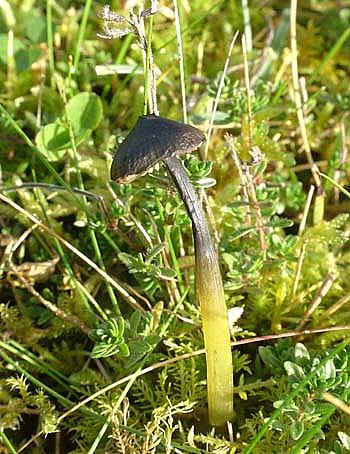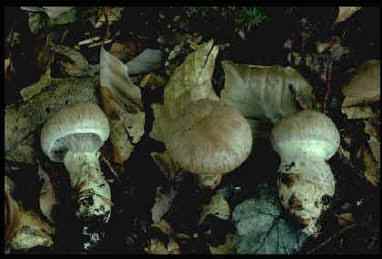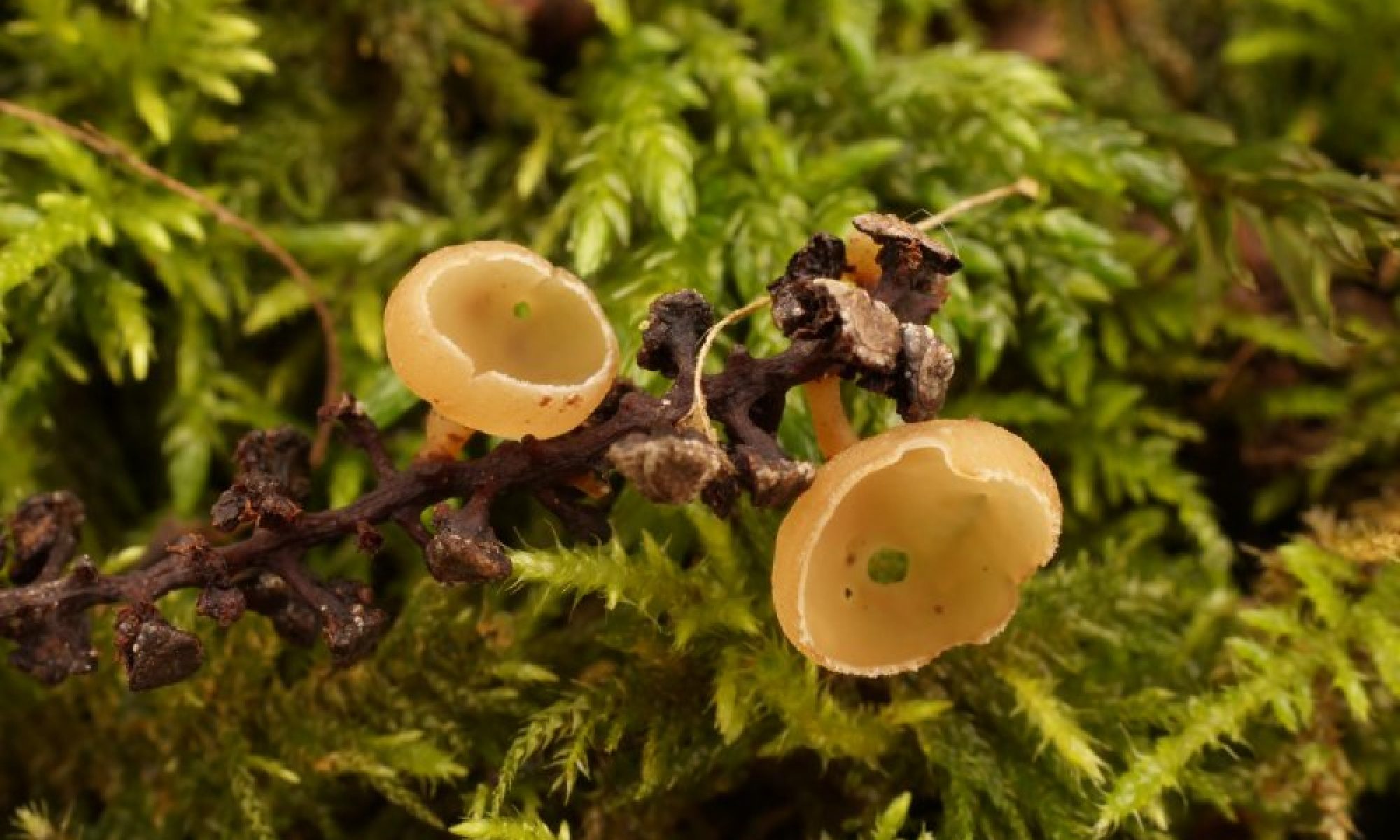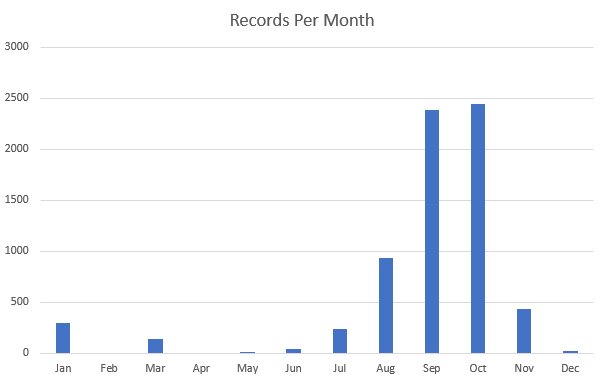The NIFG hold as many records of fungi, both our own and those already published, that we can lay our hands on. It is a fairly comprehensive dataset for what recording has been done.
We are part of the CEDaR network (Centre for Environmental Data and Recording at the Ulster Museum), so all our records can be put in context with other groups of organisms. We also supply our data to the British Mycological Society database.
This map shows the number of species recorded per 10km square in Northern Ireland up to August 2008 and the very pleasing aspect is the widespread coverage of records!
Compare this to the recording map prior to the NIFG being formed in 1996
Statistics available (last updated 2 August 2008):
The 50 most widespread species recorded so far in Northern Ireland
The most commonly recorded associated species
The Fruiting times of Ectomycorrhizal Fungi in Northern Ireland
These are some statistics from the database. If you have any other queries, I will try and answer them. Contact me at david.mitchel@nifg.org.uk
The 50 most widespread species recorded so far in Northern Ireland (last updated 2019)
These species are ranked by the number of 10km squares they have been recorded in. This is a better indication than the number of records as various recording methodologies have meant that different species are recorded in different ways. This list will also however say a lot about the recording interests of our group as well as which species are particularly abundant! There are 186 10km squares in Northern Ireland. The results certainly reflect the amount of work done on grassland fungi !!
| Rank | Species | No 10km Squares |
| 1 | Hygrocybe conica var. conica | 124 |
| 2 | Hygrocybe virginea var. virginea | 123 |
| 3 | Hygrocybe psittacina var. psittacina | 113 |
| 3 | Xylaria hypoxylon | 113 |
| 5 | Hygrocybe coccinea | 111 |
| 6 | Hygrocybe insipida | 110 |
| 7 | Trametes versicolor | 108 |
| 8 | Hygrocybe pratensis | 102 |
| 9 | Stereum hirsutum | 101 |
| 10 | Cystoderma amianthinum | 98 |
| 11 | Laccaria laccata | 97 |
| 12 | Stropharia semiglobata | 96 |
| 13 | Hygrocybe chlorophana | 93 |
| 14 | Hypholoma fasciculare | 91 |
| 15 | Hygrocybe reidii | 88 |
| 16 | Armillaria mellea | 86 |
| 16 | Hygrocybe russocoriacea | 86 |
| 18 | Collybia butyracea var. butyracea | 85 |
| 19 | Hygrocybe quieta | 83 |
| 19 | Paxillus involutus | 83 |
| 19 | Stereum rugosum | 83 |
| 22 | Russula ochroleuca | 79 |
| 23 | Rhytisma acerinum | 76 |
| 24 | Collybia confluens | 75 |
| 24 | Lactarius blennius | 75 |
| 26 | Hygrocybe ceracea | 74 |
| 26 | Hypoxylon fuscum | 74 |
| 28 | Piptoporus betulinus | 73 |
| 29 | Clavulinopsis helvola | 71 |
| 29 | Lycoperdon perlatum | 71 |
| 29 | Mycena pura var. pura | 71 |
| 32 | Clitocybe nebularis | 70 |
| 32 | Lycoperdon pyriforme | 70 |
| 32 | Pluteus cervinus | 70 |
| 35 | Lepista nuda | 69 |
| 36 | Boletus chrysenteron | 67 |
| 36 | Panaeolus papilionaceus var. papilionaceus | 67 |
| 38 | Tremella mesenterica | 66 |
| 39 | Russula mairei | 64 |
| 40 | Russula nigricans | 63 |
| 41 | Auricularia auricula-judae | 62 |
| 41 | Clavulinopsis corniculata | 62 |
| 43 | Chlorociboria aeruginascens | 61 |
| 43 | Marasmius rotula | 61 |
| 43 | Russula cyanoxantha | 61 |
| 46 | Amanita rubescens var. rubescens | 60 |
| 46 | Coprinus micaceus | 60 |
| 46 | Entoloma conferendum | 60 |
| 46 | Geoglossum fallax | 60 |
| 46 | Hygrocybe punicea | 60 |
| 46 | Laccaria amethystina | 60 |
| 46 | Lactarius subdulcis | 60 |
| 46 | Xylaria polymorpha | 60 |
| 54 | Collybia peronata | 58 |
| 55 | Coprinus comatus | 57 |
| 55 | Ganoderma australe | 57 |
| 57 | Oudemansiella mucida | 55 |
| 58 | Clitocybe fragrans | 54 |
| 58 | Lepista flaccida | 54 |
| 60 | Hygrocybe laeta var. laeta | 53 |
| 60 | Hypoxylon multiforme | 53 |
| 62 | Bolbitius vitellinus | 52 |
| 62 | Hygrocybe irrigata | 52 |
| 62 | Lactarius quietus | 52 |
| 62 | Tricholomopsis rutilans | 52 |
| 66 | Phallus impudicus | 51 |
| 67 | Coprobia granulata | 49 |
| 67 | Daedaleopsis confragosa | 49 |
| 69 | Ascocoryne sarcoides | 48 |
| 69 | Exidia thuretiana | 48 |
| 69 | Hypoxylon fragiforme | 48 |
| 69 | Nectria cinnabarina | 48 |
| 73 | Inonotus radiatus | 47 |
| 73 | Russula fellea | 47 |
| 75 | Hygrocybe fornicata | 46 |
| 75 | Russula delica | 46 |
| 77 | Calocera viscosa | 45 |
| 77 | Lycoperdon nigrescens | 45 |
| 77 | Macrolepiota rhacodes var. rhacodes | 45 |
| 80 | Leotia lubrica | 44 |
| 80 | Scleroderma citrinum | 44 |
| 82 | Agaricus arvensis | 43 |
| 82 | Clitopilus prunulus | 43 |
| 84 | Amanita muscaria | 42 |
| 84 | Clavulinopsis luteoalba | 42 |
| 84 | Flammulina velutipes | 42 |
| 84 | Hygrophoropsis aurantiaca | 42 |
| 84 | Lactarius tabidus | 42 |
| 84 | Psilocybe semilanceata | 42 |
| 90 | Armillaria gallica | 41 |
| 90 | Boletus edulis | 41 |
| 90 | Scutellinia scutellata | 41 |
| 93 | Clavulina coralloides | 40 |
| 93 | Hygrocybe virginea var. ochraceopallida | 40 |
| 93 | Vascellum pratense | 40 |
| 96 | Clavulinopsis fusiformis | 39 |
| 96 | Diatrype stigma | 39 |
| 96 | Hygrocybe miniata | 39 |
| 96 | Meripilus giganteus | 39 |
| 100 | Clavulina cinerea | 38 |
| 100 | Hygrocybe calyptriformis | 38 |
| 100 | Hygrocybe virginea var. virginea | 38 |
| 100 | Lacrymaria lacrymabunda | 38 |
| 100 | Psathyrella candolleana | 38 |

Hygrocybe conica
The most commonly recorded associated species
A word of caution with this list. Identifying which species a piece of dead wood is is not easy. Recording the species of tree an ectomycorrhizal fungi is associated with is also very difficult. The actual tree may be 100m away. This list however gives an indication of the most commonly associated species. The dominance of beech is notable given that it is not a native Irish species.
| Rank | Species | Common Name | No Records |
| 1 | Fagus sylvatica | Beech | 3453 |
| 2 | Quercus | Oak | 2108 |
| 3 | Betula | Birch | 1292 |
| 4 | Corylus avellana | Hazel | 1188 |
| 5 | Quercus petraea | Sessile Oak | 682 |
| 6 | Betula pendula | Silver Birch | 496 |
| 7 | Alnus glutinosa | Alder | 465 |
| 8 | Pinus sylvestris | Scots Pine | 449 |
| 9 | Larix | Larch | 446 |
| 10 | Betula pubescens | Downy Birch | 434 |
| 11 | Poa | Meadow-Grass | 390 |
| 12 | Pinus | Pine | 304 |
| 13 | Acer pseudoplatanus | Sycamore | 290 |
| 14 | Bos domestic | Domestic Cattle | 288 |
| 15 | Picea sitchensis | Sitka Spruce | 277 |
| 16 | Fraxinus excelsior | Ash | 264 |
| 17 | Salix | Sallow | 201 |
| 18 | Picea abies | Norway Spruce | 157 |
| 19 | Quercus robur | Pedunculate Oak | 115 |
| 20 | Tilia | Lime | 114 |
| 21 | Pseudotsuga menziesii | Douglas Fir | 109 |
| 22 | Ulex europaeus | Gorse | 97 |
| 23 | Ovis domestic | Feral Sheep | 90 |
| 24 | Ilex aquifolium | Holly | 68 |
| 24 | Ulmus | Elm | 68 |
| 24 | Crataegus monogyna | Hawthorn | 68 |
| 27 | Salix cinerea | Grey Willow | 67 |
| 28 | Sambucus nigra | Elder | 66 |
| 29 | Prunus laurocerasus | Cherry Laurel | 60 |
| 30 | Abies procera | Noble Fir | 59 |
| 30 | Pinus contorta | Lodgepole Pine | 59 |
The Fruiting times of Ectomycorrhizal Fungi in Northern Ireland
Records of the genera Boletus, Cantharellus, Cortinarius, Hydnum, Inocybe, Lactarius, Leccinum, Russula, Suillus, Tricholoma are plotted here against time. The result shows an extended fruiting season which reflects our mild oceanic climate.


